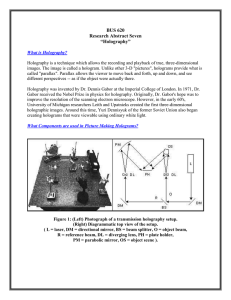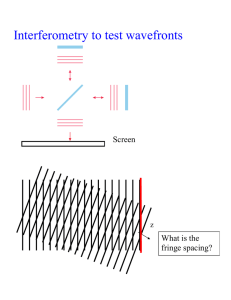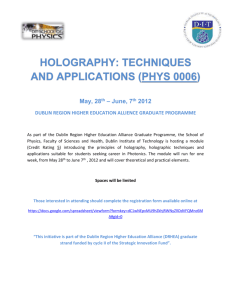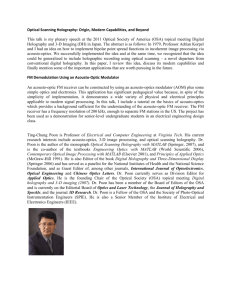Horizontal-parallax-only electronic holography
advertisement
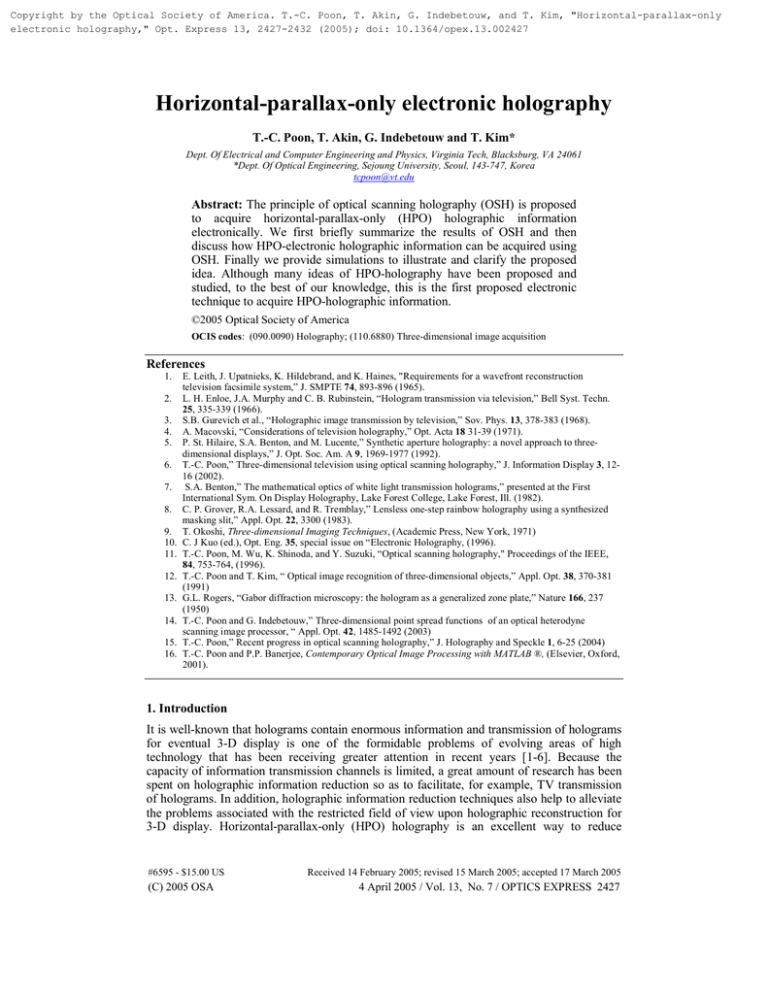
Copyright by the Optical Society of America. T.-C. Poon, T. Akin, G. Indebetouw, and T. Kim, "Horizontal-parallax-only electronic holography," Opt. Express 13, 2427-2432 (2005); doi: 10.1364/opex.13.002427 Horizontal-parallax-only electronic holography T.-C. Poon, T. Akin, G. Indebetouw and T. Kim* Dept. Of Electrical and Computer Engineering and Physics, Virginia Tech, Blacksburg, VA 24061 *Dept. Of Optical Engineering, Sejoung University, Seoul, 143-747, Korea tcpoon@vt.edu Abstract: The principle of optical scanning holography (OSH) is proposed to acquire horizontal-parallax-only (HPO) holographic information electronically. We first briefly summarize the results of OSH and then discuss how HPO-electronic holographic information can be acquired using OSH. Finally we provide simulations to illustrate and clarify the proposed idea. Although many ideas of HPO-holography have been proposed and studied, to the best of our knowledge, this is the first proposed electronic technique to acquire HPO-holographic information. ©2005 Optical Society of America OCIS codes: (090.0090) Holography; (110.6880) Three-dimensional image acquisition References 1. 2. 3. 4. 5. 6. 7. 8. 9. 10. 11. 12. 13. 14. 15. 16. E. Leith, J. Upatnieks, K. Hildebrand, and K. Haines, "Requirements for a wavefront reconstruction television facsimile system,” J. SMPTE 74, 893-896 (1965). L. H. Enloe, J.A. Murphy and C. B. Rubinstein, “Hologram transmission via television,” Bell Syst. Techn. 25, 335-339 (1966). S.B. Gurevich et al., “Holographic image transmission by television,” Sov. Phys. 13, 378-383 (1968). A. Macovski, “Considerations of television holography,” Opt. Acta 18 31-39 (1971). P. St. Hilaire, S.A. Benton, and M. Lucente,” Synthetic aperture holography: a novel approach to threedimensional displays,” J. Opt. Soc. Am. A 9, 1969-1977 (1992). T.-C. Poon,” Three-dimensional television using optical scanning holography,” J. Information Display 3, 1216 (2002). S.A. Benton,” The mathematical optics of white light transmission holograms,” presented at the First International Sym. On Display Holography, Lake Forest College, Lake Forest, Ill. (1982). C. P. Grover, R.A. Lessard, and R. Tremblay,” Lensless one-step rainbow holography using a synthesized masking slit,” Appl. Opt. 22, 3300 (1983). T. Okoshi, Three-dimensional Imaging Techniques, (Academic Press, New York, 1971) C. J Kuo (ed.), Opt. Eng. 35, special issue on “Electronic Holography, (1996). T.-C. Poon, M. Wu, K. Shinoda, and Y. Suzuki, “Optical scanning holography," Proceedings of the IEEE, 84, 753-764, (1996). T.-C. Poon and T. Kim, “ Optical image recognition of three-dimensional objects,” Appl. Opt. 38, 370-381 (1991) G.L. Rogers, “Gabor diffraction microscopy: the hologram as a generalized zone plate,” Nature 166, 237 (1950) T.-C. Poon and G. Indebetouw,” Three-dimensional point spread functions of an optical heterodyne scanning image processor, “ Appl. Opt. 42, 1485-1492 (2003) T.-C. Poon,” Recent progress in optical scanning holography,” J. Holography and Speckle 1, 6-25 (2004) T.-C. Poon and P.P. Banerjee, Contemporary Optical Image Processing with MATLAB ®, (Elsevier, Oxford, 2001). 1. Introduction It is well-known that holograms contain enormous information and transmission of holograms for eventual 3-D display is one of the formidable problems of evolving areas of high technology that has been receiving greater attention in recent years [1-6]. Because the capacity of information transmission channels is limited, a great amount of research has been spent on holographic information reduction so as to facilitate, for example, TV transmission of holograms. In addition, holographic information reduction techniques also help to alleviate the problems associated with the restricted field of view upon holographic reconstruction for 3-D display. Horizontal-parallax-only (HPO) holography is an excellent way to reduce #6595 - $15.00 US (C) 2005 OSA Received 14 February 2005; revised 15 March 2005; accepted 17 March 2005 4 April 2005 / Vol. 13, No. 7 / OPTICS EXPRESS 2427 holographic information and many holographic systems have been proposed and studied [79]. However, to the best of our knowledge, there has not been a single electronic holographic recording technique being investigated regarding the HPO-approach. Electronic holography is an electronic processing technique that is used in the context of optical holography to bypass the use of films for recording [10]. In this article, we investigate HPO-electronic holography using optical scanning holography (OSH). Optical scanning holography is a real-time holographic recording technique in which holographic recording of 3-D objects is achieved by a single 2-D laser scanning [11]. The novelty of the technique lies in the fact that holographic information of 3-D objects is done on-the-fly by laser scanning. 2. Principles of optical scanning holography Optical scanning holography is a novel 3-D imaging technique in that 3-D optical information of an object can be extracted by a 2-D optical scan of the object [11]. Briefly, in the technique an object is scanned in two dimensions simultaneously with two optical beams, a plane wave and a spherical wave, of different temporal frequencies. Photodetection of the scattered light at the heterodyne frequency then extracts the amplitude and phase (holographic) information of the scattered field. We now review recording and reconstruction briefly. With reference to Fig. 1, the AOM is an acousto-optic frequency shifter to shift the temporal frequency of the laser beam directed from beamsplitter BS1. The AOM operates at frequency Ω. BE1 and BE2 are laser beam expanders to provide collimated beams. One of the collimated beams is focused by lens L to form a point source on beamsplitter BS2, which generates a spherical wave away from the focused spot toward the 3-D object. The other collimated beam from BE2 forms a plane wave. The spherical wave and the plane wave are combined by beamsplitter BS2 to form the so-called time-dependent Fresnel zone plate (TDFZP) [11], which is then projected through the x-y scanning mirrors unto the 3-D object, I 0 ( x, y; z ) . The scattered light from the object is detected by a photodetector, which gives a heterodyne current i( x , y ) at frequency Ω as an output. The heterodyne current contains holographic information of the object being scanned, which can be directly radiated by an antenna. This radiated holographic information can now be received from an antenna in the remote site for reconstruction. Antennas Cos ( Ω t ) i( x, y ) M1 is( x , y) LPF Laser M3 LPF Photo-detector BS1 AOM Cos ( Ω t ) Sin (Ω t ) ic( x, y) SLM or PC BE1 L Io( x , y; z ) M2 BE2 BS2 z X-Y Scanner z0 Fig. 1. Typical optical scanning holography setup: M1,M2 and M3 are mirrors, BS1 and BS2 are beamsplitters. LPFs are electronic lowpass filters, and ⊗ ’s are electronic multipliers #6595 - $15.00 US (C) 2005 OSA Received 14 February 2005; revised 15 March 2005; accepted 17 March 2005 4 April 2005 / Vol. 13, No. 7 / OPTICS EXPRESS 2428 Reconstruction of holographic information is done by electronic demodulation, which consists of electronic multipliers and lowpass filters as shown in Fig. 1. The two demodulated currents, i c ( x, y) and i s ( x, y ) , when stored or displayed in synchronization with the x-y scanner in a computer or spatial light modulators (SLMs), become two 2-D records and are called the cosine- and the sine- holograms, respectively [12]. For a simple example in a planar object located at z = 0, that is, I 0 ( x , y; z ) = I 0 ( x , y )δ( z ) , i c ( x, y) becomes cos[ π ( x 2 + y 2 )] ⊗ I 0 ( x , y ) . λz 0 (1) In Eq. (1), λ is the wavelength of the laser, z 0 is the distance from the focused spot on beamsplitter BS2 to the 3-D object, z is the depth parameter of the object, and finally ⊗ denotes 2-D correlation involving x and y coordinates. In summary, when the object is scanned by a 2-D time-dependent Fresnel zone plate, the end result is that a cosine-Fresnel zone plate correlates with the object to give a cosine-hologram. This is illustrated graphically in Fig. 2, where the object is a planar object with the text "Virginia Tech." The sinehologram, i s ( x, y ) is obtained simultaneously and given by replacing the cosine function with the sine function in Eq. (1). It is interesting to point out that we can consider optical scanning holographic recording as a collection of zone plates as evident by Eq. (1) [13]. Note that both the cosine- hologram and sine-hologram are on-axis holograms and if we want to completely reject the twin-image noise, we can construct a complex hologram as (2) H c ( x, y) = i c ( x, y) ± ji s ( x, y) . The choice of the plus sign or the minus sign in Eq. (2) allows us to choose either a real image or a virtual image reconstruction [14, 15]. cos[ π ( x 2 + y 2 )] λz 0 I 0 ( x, y) Fig 2. Cosine hologram obtained by correlation of cosine-Fresnel zone plate with the object 3. Horizontal-parallax-only holography It has been calculated that for a full parallax 20mm x 20mm on-axis hologram and a viewing angle of 60 degrees with red light reconstruction, the required number of resolvable pixels is about 1.1 billion in the hologram, well beyond the current capabilities of a real-time spatial light modulator (SLM) if the hologram is to be displayed on it for coherent reconstruction. In addition, to update such a hologram dynamically with 8-bit resolution at 30 frames per second, a serial data transfer rate of 0.26 Terabit/sec is required for full parallax; again well beyond the current capacities of data transfer rate if the size of the hologram is getting larger [6]. However, if we are satisfied with only horizontal parallax, and for a 512 vertical lines, the number of pixels required and the data transfer rate become 17 millions and 4 Giga-bits per second, respectively. This is tangible with current technologies and the possibility with realtime holographic TV becomes a reality if HPO-electronic holographic recording technique becomes available. Indeed, using computer-generated horizontal-parallax-only holographic information, a 3-D holographic display has been demonstrated by the MIT group with 64 vertical lines with viewing angle of about 15 degrees [5]. However, the HPO-holographic #6595 - $15.00 US (C) 2005 OSA Received 14 February 2005; revised 15 March 2005; accepted 17 March 2005 4 April 2005 / Vol. 13, No. 7 / OPTICS EXPRESS 2429 information is generated by a super computer, and no HPO-holographic information has been generated or recorded from actual real objects. In this article, we suggest ways of generating HPO-holographic information from real objects electronically. By recognizing that OSH is accomplished by scanning the 3-D object with a 2-D time-dependent Fresnel zone plate (TDFZP), we can visualize that horizontal-parallax-only optical scanning holography can be accomplished by 2-D scanning of the object by a 1-D TDFZP to obtain holograms. Under this context, Eq. (1) becomes cos( π 2 x y x ) exp[ −( ) 2 − ( ) 2 ] ⊗ I 0 ( x, y) , λz 0 ωx ωy (3) where we have modeled the 1-D scanning zone plate by masking the 2-D zone plate with a narrow Gaussian function. With ωx » ωy, there will be no variation of the zone plate along the y-direction. This is illustrated conceptually in Fig. 3. Each 1-D scan of the object generates a single line called the "holo-line." Note that each holo-line only contains holographic contributions only from points that lie on a single horizontal line of the object. By stacking the holo-lines vertically, we obtain horizontal-parallax-only holograms. In contrast, by scanning with a 2-D zone plate, each scan line contains holographic contributions from the whole object and thereby obtaining a full-parallax hologram [see Fig. 2]. Holo-line: contains holographic contributions only from points that lie on a single horizontal line of the object HPO hologram : stack of holo-lines Fig. 3. Concept of HPO-optical scanning holography The 1-D time-dependent FZP, for example, can be obtained by properly masking the 2-D time-dependent FZP by a horizontal slit, placed after the beampsplitter BS2 in Fig. 1. The masked 2-D FZP is then imaged onto the 3-D object by a lens. Indeed, for example, by performing 2-D scanning of the 1-D TDFZP onto the 3-D object, we can record two HPOholograms: the HPO-cosine hologram [see Eq. (3)] and the HPO-sine hologram when the cosine function is replaced by the sine function in Eq. (3). 5. Simulation results We clarify the idea of HPO-holography by performing some simulations. Figure 4(a) show an object consisting of 4 dots, and Fig. 4(b) displays an example of the 1-D scanning FZP: cos( #6595 - $15.00 US (C) 2005 OSA x y π 2 x ) exp[ − ( ) 2 − ( ) 2 ]. λz 0 ωx ωy (4) Received 14 February 2005; revised 15 March 2005; accepted 17 March 2005 4 April 2005 / Vol. 13, No. 7 / OPTICS EXPRESS 2430 In Fig. 4(c), we show the result of Eq. (3), which is the HPO-cosine-hologram of Fig. 4(a). Figure 4(d) shows the HPO-sine-hologram of Fig. 4(a). We can construct a complex HPOhologram according to Eq. (2) using the two holograms, and when it is displayed on some phase SLM we can reconstruct the hologram coherently without any twin image noise. Fig. 5 shows its optical reconstruction by computer simulations. This is simply done by convolving digitally the complex HPO-hologram with the free space impulse response at a distance z 0 [16]. The result is interesting in that we see along the x-direction the “dots” are properly holographically focused. However, along the y-direction, the light spread, which is due to the slit-type holograms for each point of the object. To compensate this vertical spreading, we propose Fig. 6 for optical reconstruction. A cylindrical lens of focal length of z 0 / 4 would compensate the y-spreading. Reconstruction simulation results show the original object given by Fig. 4(a). Fig. 4. (a) Object of 4 dots Fig. 4. (b) 1-D scanning FZP Fig. 4. (c) HPO-cosine-hologram of Fig. 4(a) Fig. 4. (d) HPO-sine-hologram of Fig. 4(a) Fig. 5 Simulation result of optical reconstruction of complex-HPO hologram #6595 - $15.00 US (C) 2005 OSA Received 14 February 2005; revised 15 March 2005; accepted 17 March 2005 4 April 2005 / Vol. 13, No. 7 / OPTICS EXPRESS 2431 HPO-Hologram y x Reconstruction plane Fig. 6 Proposed optical reconstruction for HPO-hologram 6. Concluding remarks While 3-D display of computer-generated horizontal-only-parallax (HPO) holograms have been demonstrated [5], to the best of our knowledge, this is the first time the recording of horizontal-only-parallax holographic information from real objects has been proposed in the context of electronic holography. This can be achieved by 2-D active optical scanning of a 1D time-dependent FZP onto the 3-D object to obtain eventually a complex HPO-hologram. The 1-D time-dependent FZP is obtained by masking the 2-D FZP by a horizontal slit under the setup of optical scanning holography. In this article, we have performed simulations of the idea and verified that it is capable of holographic reconstruction with the proposed optical reconstruction system shown in Fig. 6. However, there are certain aspects that need to be considered. For instance, the slit size is an important parameter. Assuming an object size of w by w with depth d, the number of holo-lines is then given by w/ωy, and the larger this number is (i.e., the smaller the slit size ωy), the better the resolution along the y-direction. However, we also want to have this number of lines about the same throughout the thickness of the 3-D object. This means that we cannot arbitrary set ωy to be small to gain resolution along the ydirection. As ωy gets too small, we would have a strong spread along y after the propagation distance d across the depth of the object, thereby spoiling resolution along y at the back of the object. Hence, there is an optimal slit size for a given 3-D object. Lastly, we point out that since there is a 3-D display system for HPO-electronic holograms already [5], and with the present proposed system, one could acquire HPO-electronic holographic information from real objects. We envision the incorporation of the two systems to finally achieve the goal of 3D holographic television system in the near future. Acknowledgments The work is supported by the Ministry of Information & Communications, Korea, under the Information Technology Research Center (ITRC) Support Program. #6595 - $15.00 US (C) 2005 OSA Received 14 February 2005; revised 15 March 2005; accepted 17 March 2005 4 April 2005 / Vol. 13, No. 7 / OPTICS EXPRESS 2432
